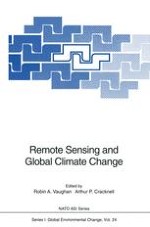1994 | OriginalPaper | Chapter
Remote Sensing of Snow and Ice and Its Relevance to Climate Change Processes
Author : Peter Wadhams
Published in: Remote Sensing and Global Climate Change
Publisher: Springer Berlin Heidelberg
Included in: Professional Book Archive
Activate our intelligent search to find suitable subject content or patents.
Select sections of text to find matching patents with Artificial Intelligence. powered by
Select sections of text to find additional relevant content using AI-assisted search. powered by
This chapter will review those physical processes in snow and ice which are important to climate change, and will describe how remote sensing techniques are used to map the cryosphere and hence to allow the magnitude and direction of climatic change in the polar regions to be estimated. The review begins with a brief overview of the structure and morphology of ice and snow and the geophysical processes in which ice and snow are involved. We then consider the physics of interaction between electromagnetic waves and a snow or ice surface and the remote sensing techniques commonly used to study ice and snow (including acoustic as well as electromagnetic methods). The greenhouse effect is described with reference to the cryospheric processes which cause the rate of warming to be enhanced in north polar regions. We point out the importance of ice and snow processes in amplifying the rate of ground level warming, and how ice and snow parameters can be used as early indicators of climatic change in action. We go on to consider in detail how remote sensing techniques are used to monitor four key parameters. These are (1) the contribution of melting glaciers and ice sheets to the rate of global sea level rise; (2) the evidence for a retreat of sea ice in the polar regions; (3) the problem of the synoptic mapping of sea ice thickness, and the evidence for thinning of sea ice; (4) the evidence for a retreat of seasonal snowpack in the northern hemisphere.
